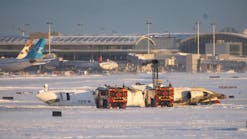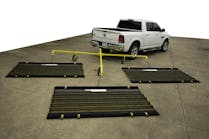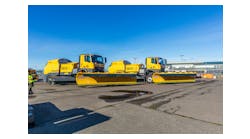KwikBond Polymers was founded over 36 years ago, with a goal of developing a product that was better than concrete – offering more durability and longevity. KiwkBond PPC 1121 was the result, and as Bobby Scarpitto, KwikBond’s upper midwest regional manager, points out the product has so far withstood the test of time – literally.
“Then those two [KwikBond’s founders] actually were part of the installation of the first bridge deck, which is still in existence today, by the way. So, 36+ years later, still the first bridge deck that was done with this technology is still in existence, still operating and still has a great surface finish,” Scarpitto said.
PPC 1121 is “near-permanent,” Scarpitto added. It can be used for both patching and repairing surfaces and as an overlay. Essentially, it is the same resin technology used to make boats, countertops and camper shells, but with a more engineering behind it.
KwikBond is used often for road repair by state’s Department of Transportations (DOTs) on roads. Scarpitto said they can by found in 46 states, but his dream is to have PPC used for a runway.
“We're in 46 states, we're working with a lot of people, cities, counties, DOTs, all the likes, some airports,” he said. “My goal and dream is to use traditional concrete as the base material, as the substrate for a two-inch or four-inch thick overlay, as a runway in tarmac situations.”
Scarpitto said he’s started the process with the FAA to turn PPC 1121 into a runway someday. In the meantime, it’s been used for the departure lanes at LAX and the Dreamliner parking at San Francisco International Airport, among numerous other projects.
“One of the claims to fame is you can return to traffic in almost any temperature in just under two hours or just at two hours,” Scarpitto said. “I've done it as low as minus 32 and as high as 120 degrees. And these are deck temperatures, not ambient temperatures. So, it has a broad working range. And again, the cure rate is determined by chemistry, not by ambient temperatures.”
The process to use the polymer starts by sawing out the cracked or damaged area of concrete. After all the damaged concrete is removed, a primer is applied to the remaining good concrete, creating the root system of the polymer. PPC 1121 is then applied and finished like traditional concrete, using even the same tools. Finally, a small amount of sand is used on the top surface to create a weather surface. Then it is left to cure.
“Through resin technology and through resin chemistry, we add a promoter and a catalyst to it,” Scarpitto said. “You have about 30 minutes to work this material, and then it starts its crosslinking or chemical process. It's not only bonding to the concrete below it and beside it, but it's also turning into hard plastic, is the best way to describe it.”
After applied, Scarpitto said traffic can return to the surface in as little as two hours.
“It has about a 7,000 PSI rating. As far as concrete goes, that's extremely tough. It also has a low modulus of elasticity so it is flexible. It looks, acts and sounds and feels like concrete,” he said, adding that it expands and contracts the same as the surrounding concrete, as well. “We're impervious to salts, we're impervious to chlorides. So, you can throw all the chemicals you want at it to keep snow off. All the oils and fuels that spill on top of this material are really going to have no net effect to it.”
The future of KiwkBonds is using it for an entire runway, Scarpitto hopes.
“I think probably the biggest thing that I need is an open mind and the opportunity to present this material. We make an offer to all DOTs and this offer stands for airports as well. I like to affectionately call it the one cubic yard challenge. I give the DOT or an airport a cubic yard of material for free. I come in and train their maintenance people on how to mix and place this material.
Part of my job also is traveling around as a technical trainer and I come in and train them on how to use this material, and then simply wait and see what it does. We're not asking for anything. We're not asking for an order today, but watch and see what the material does and learn what we know, and I'll make a believer out of any airport or DOT that allows me the opportunity for the challenge,” Scarpitto said.






